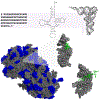Targeting RNA with Small Molecules To Capture Opportunities at the Intersection of Chemistry, Biology, and Medicine
- PMID: 30896935
- PMCID: PMC6541398
- DOI: 10.1021/jacs.8b13419
Targeting RNA with Small Molecules To Capture Opportunities at the Intersection of Chemistry, Biology, and Medicine
Abstract
The biology of healthy and disease-affected cells is often mediated by RNA structures, desirable targets for small molecule chemical probes and lead medicines. Although structured regions are found throughout the transcriptome, some even with demonstrated functionality, human RNAs are considered recalcitrant to small molecule targeting. However, targeting structured regions with small molecules provides an important alternative to oligonucleotides that target sequence. In this Perspective, we describe challenges and progress in developing small molecules interacting with RNA (SMIRNAs) to capture their significant opportunities at the intersection of chemistry, biology, and medicine. Key to establishing a new paradigm in chemical biology and medicine is the development of methods to obtain, preferably by design, bioactive compounds that modulate RNA targets and companion methods that validate their direct effects in cells and pre-clinical models. While difficult, demonstration of direct target engagement in the complex cellular milieu, along with methods to establish modes of action, is required to push this field forward. We also describe frameworks for accelerated advancements in this burgeoning area, their implications, key new technologies for development of SMIRNAs, and milestones that have led to broader acceptance of RNA as a small molecule druggable target.
Figures









References
-
- Holley RW; Apgar J; Everett GA; Madison JT; Marquisee M; Merrill SH; Penswick JR; Zamir A Structure of a Ribonucleic Acid. Science (Washington, DC, U. S.) 1965, 147 (3664), 1462–5. - PubMed
-
- Jones D; Metzger HJ; Schatz A; Waksman SA Control of gram-negative bacteria in experimental animals by streptomycin. Science 1944, 100 (2588), 103–105. - PubMed
-
- Finken M; Kirschner P; Meier A; Wrede A; Bottger EC Molecular basis of streptomycin resistance in Mycobacterium tuberculosis: alterations of the ribosomal protein S12 gene and point mutations within a functional 16S ribosomal RNA pseudoknot. Mol. Microbiol 1993, 9 (6), 1239–46. - PubMed
Publication types
MeSH terms
Substances
Grants and funding
LinkOut - more resources
Full Text Sources
Other Literature Sources
Medical

